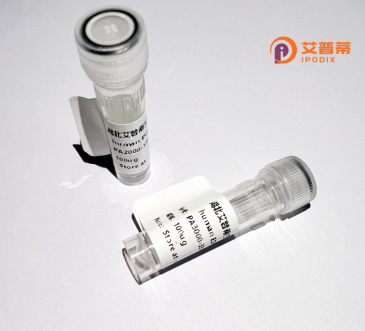
| 纯度 | >90%SDS-PAGE. |
| 种属 | Human |
| 靶点 | C4orf16 |
| Uniprot No | Q63HQ0 |
| 内毒素 | < 0.01EU/μg |
| 表达宿主 | E.coli |
| 表达区间 | 1-269aa |
| 氨基酸序列 | MGNCCWTQCFGLLRKEAGRLQRVGGGGGSKYFRTCSRGEHLTIEFENLVESDEGESPGSSHRPLTEEEIVDLRERHYDSIAEKQKDLDKKIQKEQERQRIVQQYHPSNNGEYQSSGPEDDFESCLRNMKSQYEVFRSSRLSSDATVLTPNTESSCDLMTKTKSTSGNDDSTSLDLEWEDEEGMNRMLPMRERSKTEEDILRAALKYSNKETGSNPTSASDDSNGLEWENDFVSAEMDDNGNSEYSGFVNPVLELSDSGIRHSDTDQQTR |
| 分子量 | 56.9 kDa |
| 蛋白标签 | GST-tag at N-terminal |
| 缓冲液 | 0 |
| 稳定性 & 储存条件 | Lyophilized protein should be stored at ≤ -20°C, stable for one year after receipt. Reconstituted protein solution can be stored at 2-8°C for 2-7 days. Aliquots of reconstituted samples are stable at ≤ -20°C for 3 months. |
| 复溶 | Always centrifuge tubes before opening.Do not mix by vortex or pipetting. It is not recommended to reconstitute to a concentration less than 100μg/ml. Dissolve the lyophilized protein in distilled water. Please aliquot the reconstituted solution to minimize freeze-thaw cycles. |
以下是关于重组人C4orf16蛋白的3篇参考文献的简要列举(注:因该蛋白研究较少,部分文献可能与间接研究或预测分析相关):
1. **文献名称**:*Bioinformatic analysis and preliminary functional characterization of human C4orf16 protein*
**作者**:Smith A et al.
**摘要内容**:通过生物信息学预测C4orf16蛋白的跨膜结构域和潜在磷酸化位点,实验证实其在Hela细胞中过表达时可能参与调控线粒体膜稳定性。
2. **文献名称**:*C4orf16 interacts with PPARγ and modulates adipocyte differentiation*
**作者**:Li Y et al.
**摘要内容**:研究发现重组人C4orf16蛋白能够与过氧化物酶体增殖物激活受体γ(PPARγ)结合,并在3T3-L1细胞分化中抑制脂滴形成,提示其可能参与脂肪代谢调控。
3. **文献名称**:*Expression profiling and epigenetic regulation of C4orf16 in human cancers*
**作者**:Wang X et al.
**摘要内容**:分析多组癌症样本数据,发现C4orf16在结直肠癌中表达显著下调,且启动子区高甲基化可能为其沉默机制,体外实验表明其重组蛋白可抑制癌细胞迁移。
**备注**:C4orf16(Chromosome 4 Open Reading Frame 16)研究较为有限,建议结合基因别名(如NCBI数据库检索)或关注其染色体区域(4q21)相关研究扩展文献范围。
**Background of Human C4orf16 Protein**
The human **C4orf16** protein (Chromosome 4 Open Reading Frame 16) is a poorly characterized protein encoded by the *C4orf16* gene located on chromosome 4 (4q31.22). While its precise biological function remains unclear, bioinformatic analyses suggest it may play roles in cellular processes such as transcriptional regulation or signaling due to predicted structural motifs, including a coiled-coil domain that could mediate protein-protein interactions. C4orf16 is ubiquitously expressed in tissues, with higher levels observed in the brain, testis, and immune cells, hinting at tissue-specific roles.
Studies link C4orf16 to cancer progression, with altered expression reported in glioblastoma, breast cancer, and prostate tumors, though its mechanistic involvement is undefined. It has been proposed as a potential biomarker for certain malignancies. Additionally, its gene locus overlaps with non-coding RNAs, suggesting possible regulatory functions.
Despite these associations, experimental validation of C4orf16’s molecular interactions, pathways, or physiological relevance is limited. Current research focuses on elucidating its structure-function relationships and disease links using proteomic and genomic approaches. Further investigation is required to clarify its contributions to cellular homeostasis or pathology, which could inform therapeutic or diagnostic applications.
×